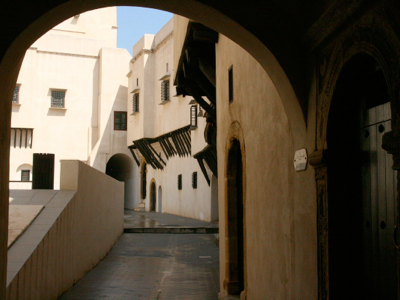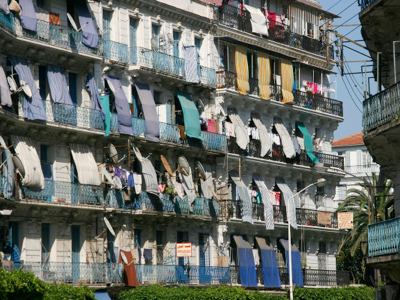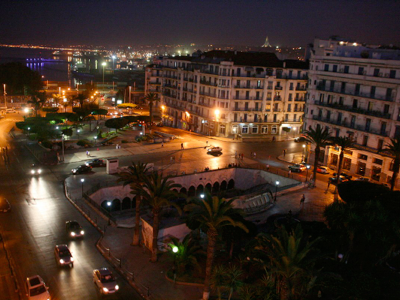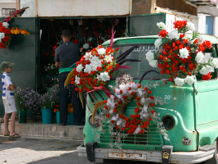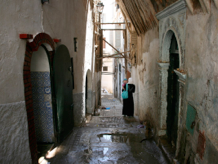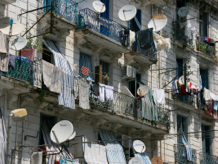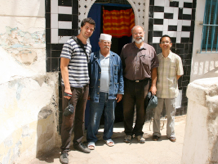North Africa ‘Plus’ Travel Diary

2011
Turkey Tunisia Algeria Iran Transnistria
A full day in Algiers. For some people, it might sound like winning first prize in a competition where second prize was spending two days in Algiers.
Yong, the bright, resourceful and energetic young man from Malaysia who helped me organise my time in Algeria, told me the story today of a man he had known who went to an Algerian Embassy to organise a tourist visa, only to be turned away on the grounds that “there is nothing to see in Algeria”.
And so, with what could optimistically be described as ‘medium-level’ expectations (at best), we set off with Yong and Badjou this morning to explore Algiers. Our first sight did not engender confidence as a long fleet of blue vans with wired-caged windows drove along the street where our hotel is located (Rue Pasteur) - they were the riot police getting into position for the day. Actually, we saw sub-fleets of the riot police vans and their armed soldiers in many parts of the city as we travelled around, but it turned out that their “welcome presence” was just precautionary. Today was, as far as we are aware, riot-free - unlike two days ago when a bomb exploded just 40 kilometres east of Algiers (link here).
We began our explorations beside the old harbour, near the Place des Martyrs. The old harbour is still used - by a curious mix of small fishing boats and Algerian Navy vessels, as a result of which close exploration was impossible. Nonetheless, this is the area where settlement in Algiers began, first by the Phoenicians, and then by a succession of invading forces. As well as the lively waterfront scene, it was also interesting to observe the progress of construction of Algiers’ new metro (subway) system. The short first line of the system has been under construction now for about 30 years, and no opening date has yet been announced - though to be fair, construction did stop for about ten years (from the mid-1990s to about 2005) when it was realised that the tunnels under construction made perfect access routes to key city locations for terrorists.
A short walk from the Place des Martyrs brought us to the Palais des Raïs. We had seen the exterior of this building during our walk last Friday, but like everything else in Algiers on that day, it had been closed. Today, we had the experience of going inside. The ‘palace’ is a row of beautifully renovated large waterfront houses, joined up to form a single compound. Most of the buildings were built in the mid to late 1700s, and the renovation work has been exquisitely done. Although most of the rooms were fairly small (with VERY thick walls), many were elaborately decorated with tiles and painted ceilings, and walking through the various buildings gave a wonderful insight into the privileged life of the occupying Ottomons, then French, officials in their heyday.
Our main destination for the morning was the Casbah, the old part of Algiers that was built between the 16th and 18th centuries and which sits on the steep hill that rises just behind the seafront. It is an area of narrow, winding laneways and often decrepit tall, white-washed houses, many of which remain damaged from the earthquake in 2008. It is an area known for its lawlessness, petty thieving, earthiness, squalor and colourful local character.
Our walk through the Casbah began at what looked like a small mosque, but which was in fact a tomb. As approached the tomb along a narrow set of downwards steps, a lady offered each of us half a fresh baguette with chocolate filling, a common custom that everyone present seemed to be enjoying, and apparently representing the spreading of the sweetness of the Prophet’s words. Unlike most parts of the Islamic world, people come here to pray to the spirit of the dead person, and in a further deviation from normal Islamic practice, both men and women were in the same room without any separation screen, although they did choose to sit on opposite sides of the tomb to pray.
Our walk through the Casbah revealed a vibrant but fairly poor community living in buildings of varying states of disrepair. We paused to explore two small museums in courtyard-style buildings, one showing artifacts and clothing from different parts of Algeria, and the other showing an exquisite collection of Islamic calligraphy. Our morning concluded with a short drive to lunch at a wonderful restaurant known as La Maison de Couscous, where contrary to the place’s name, I had a great meal of traditional chakhchoukha while Tim had a tagine.
After lunch, our first stop was the magnificent Catholic cathedral known as Notre Dame d’Afrique, or more commonly by the locals as “Madame Afrique”. The basilica, a mix of Romanesque and Byzantine architecture adorned tastefully with a wide strip of Algerian tile decoration, was consecrated in 1872 by Bishop Lavigerie, founder of the White Fathers. It had fallen into a sad state of disrepair before being recently renovated; in fact, it has only been reopened to visitors for the past two months.
The interior of the building was a work of art in itself. Its walls were covered by various small memorial plaques, and on either side of the main altar it had scenes from the last week of Christ’s earthly life (to the right) and scenes from the history of the early Christian church (to the left). Above the main altar was a stunning mural showing the infant Jesus as the centrepiece or worship above the modern city of Algiers and a mosaic that we had seen in Tipaza dating back to the early days of the Christian church in Algeria. Beneath the mosaic were the extraordinary words in French meaning “Our Lady of Africa, pray for us and for the Muslims”.
I should also add that the views of Algiers from the front of the church, situated on a high hill overlooking the Mediterranean coastline to the north-east and the centre of the city to the south-east, were some of the best we had of the city.
Our final exploration for the day was spent in the area known as Bab el-Oued. Traditionally a centre for political ferment, the presence of the riot police was especially evident in this area. Most of the buildings dated from the French era, and some of the streets had been taken over by stalls selling everyday goods to the people, an activity that is apparently illegal but tolerated for several reasons that were explained to us.
Our day’s explorations had shown us a diverse and vibrant city, one that was far more interesting than either the guidebook or that anonymous embassy official might have led us to believe. I’m not sure I would necessarily choose to live in Algiers, but I am very pleased to have had the opportunity to visit and explore some of its many facets.

Day 16 - Algiers, Algeria
Tuesday
28 June 2011
Today’s Bonus Images








